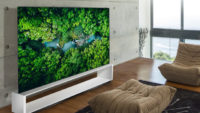8K Slow to Take Hold in Homes but Transforming Production
April 29, 2022
At NAB 2022 in Las Vegas, 8K sets hinted at a home viewing revolution. With 16 times the resolution of HD and four times the 4K screens currently in about 44 percent of U.S. households, the 8K experience represents a leap in immersive viewing. Sony, LG and TCL have been selling 8K sets, but globally only 1 million were purchased. But there are ways 8K is being put to use today to benefit a variety of end-use cases. Virtual production and virtual reality are two instances where content displayed in 4K or HD still benefits from the higher-resolution capture, while 8K also offers added flexibility in post production.
Strategy Analytics says that “about 72 million households worldwide will have an 8K set in 2025,” writes TV Technology, pointing out that is “a tiny fraction of the 1.7 billion homes with TV sets in the world.”

NAB Amplify predicts that while “8K TV displays are barely on the consumer’s radar anywhere outside Japan,” that will change by 2030, when “they will be as mainstream as 4K TVs are today and HD sets were a decade ago,” with prices already down to about $3,000 for some models, down from about $12,000 in 2017.
“If you have ever viewed immersive 8K content, especially paired with phenomenal audio, it is an experience that is unmatched,” Hugo Gaggioni, CTO of Sony Electronics Professional Solutions of America, told TV Technology.
Sony’s professional division makes equipment used in 8K production, including the Venice 2 (below), a compact digital cinema camera with 16 stops of exposure latitude. Blackmagic Design’s URSA Mini Pro 12K has a native resolution of 12,288 x 6,480 — which translates to 80 megapixels per frame, according to the company.

The new 6P color system was on display at NAB, demonstrating how it can help the TV sets of the future sing. Working with existing cameras, 6P greatly expands the range of colors memorialized in capture. “This is not just bit-depth or gamut, it’s not just chromaticity and luminosity. This is a compendium of neurologic cues that our audiences have never experienced,” says cinematographer Steven Poster, who is working with 6P’s developers, including technologists from Baylor University.
At the moment, 8K content is mainly being offered in Japan and China. Ikegami marketing executive Hiroshi Akiyama told TV Technology his company’s 8K cameras “are used for major sporting events, music programs, and are broadcast live on Japan’s NHK BS8K,” an 8K satellite channel. “In addition to NHK producing about 200 hours of 8K video during the Summer Olympics in Tokyo, Chinese broadcasters have also embraced the format.”
The 8K format offers producers more flexibility in post, where the higher resolution enables things like shot reframing. Sony’s Venice 2 8K camera opens the door to such options. “We have seen many productions down-res to 4K or 5.7K and still use the Venice 2-inch camera from Sony,” Gaggioni told TV Technology, which writes that “creating 8K masters protects the long-term value of content that might be distributed in HD or 4K today, vendors say.”

No Comments Yet
You can be the first to comment!
Sorry, comments for this entry are closed at this time.